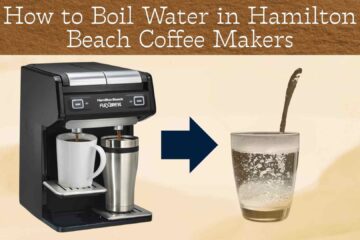Maintaining a clean Keurig coffee maker is essential for ensuring your daily cup of coffee is both delicious and safe. Regular cleaning not only prolongs the lifespan of your machine but also enhances the flavor of your brew. Neglecting maintenance can lead to several issues that affect both the taste and functionality of your coffee maker.
Common Issues Due to Lack of Maintenance:
- Clogging: Over time, mineral deposits from hard water can accumulate inside the machine, leading to blockages that hinder water flow and brewing efficiency.
- Taste Problems: Residual coffee oils and mineral buildups can impart unpleasant flavors to your coffee, making each cup less enjoyable.
- Mold and Bacteria Growth: The warm, moist environment of your Keurig is ideal for mold and bacteria proliferation, which can contaminate your coffee and pose health risks.
Introducing Vinegar as a Cleaning Solution:
White distilled vinegar is a natural, non-toxic cleaner that effectively breaks down mineral deposits and eliminates mold and bacteria. Its mild acidity makes it safe for your machine while ensuring a thorough clean. Using vinegar is also cost-effective and environmentally friendly, making it a popular choice among Keurig owners.

Why Should You Clean Your Keurig Coffee Maker?
Regular cleaning of your Keurig is crucial for optimal performance and the quality of your coffee. Let’s explore the primary reasons:
Build-up of Mineral Deposits
Hard water contains minerals like calcium and magnesium that can accumulate inside your Keurig over time, forming scale. This buildup can clog essential components, affecting water flow and heating efficiency, leading to longer brewing times and inconsistent temperatures. Descaling helps prevent these issues, ensuring your machine operates smoothly.
Mold and Bacteria Growth
The damp environment within your Keurig, especially in areas like the water reservoir and K-Cup holder, can harbor mold and bacteria if not cleaned regularly. This microbial growth can lead to health concerns and negatively impact the taste of your coffee. Regular cleaning and maintenance help prevent such growth, ensuring a hygienic brewing process.
Taste Quality
Residual coffee oils and mineral deposits can accumulate inside your Keurig, affecting the taste of your coffee. Regular cleaning ensures that each cup is fresh and free from unwanted flavors, providing a consistently enjoyable coffee experience.
Why Vinegar Works as a Cleaning Agent
Vinegar is a household staple renowned for its versatility, especially when it comes to cleaning your Keurig. Here’s why it’s so effective:
Natural and Effective
White distilled vinegar contains about 5% acetic acid, which is effective in dissolving mineral deposits and breaking down mold and bacteria. Its natural composition makes it a powerful cleaner without the use of harsh chemicals.
Affordable and Accessible
Vinegar is an economical solution readily available in most households. Its affordability makes it a practical choice for regular maintenance without the need for expensive commercial cleaners.
Non-Toxic Alternative
Unlike some chemical cleaners, vinegar is non-toxic and environmentally friendly. Using it ensures that no harmful residues remain in your coffee maker, providing peace of mind with every brew.
Is It Safe to Use Vinegar in Your Keurig?
Using vinegar to clean your Keurig is both safe and effective when done correctly. Let’s address some common concerns:
Addressing Concerns About Using Vinegar
- Acidity: Vinegar’s mild acidity is effective in breaking down mineral deposits without damaging your machine’s components. However, it’s important to use the right concentration and follow recommended cleaning procedures.
- Potential for Damage: When used properly, vinegar does not harm the internal parts of your Keurig. It’s a gentle yet effective cleaning agent that helps maintain your machine’s longevity.
Reassurance on Vinegar’s Safety
Many Keurig users have successfully used vinegar for cleaning without any adverse effects. It’s a trusted method endorsed by both users and experts alike.
Precautions
To ensure safe and effective cleaning:
- Dilution: Mix equal parts of white vinegar and water to create a cleaning solution. This dilution helps in effectively removing deposits without leaving a strong vinegar smell.
- Quantity: Use enough solution to fill the water reservoir completely, ensuring that the entire internal system is cleaned thoroughly.
- Rinsing: After the cleaning cycle, run multiple water-only cycles to flush out any remaining vinegar residue, ensuring your coffee tastes as it should.
Step-by-Step Guide to Cleaning Your Keurig with Vinegar
Regular cleaning of your Keurig coffee maker ensures optimal performance and extends its lifespan. Using white distilled vinegar is an effective and natural method for descaling and sanitizing your machine. Here’s a comprehensive guide:
Step 1: Prepare Your Keurig
- Unplug the Machine: Safety first! Always unplug your Keurig before cleaning to prevent any electrical hazards.
- Remove Removable Parts:
- K-Cup Holder: Take out the K-Cup holder and rinse it under warm water to eliminate any coffee grounds.
- Water Reservoir: Remove the water reservoir and empty any remaining water.
- Drip Tray: Take out the drip tray and empty any liquid.
- Clean Removable Parts:
- Wash the K-Cup holder, water reservoir, and drip tray with warm, soapy water.
- Use a non-abrasive sponge to scrub away any residue.
- Rinse thoroughly and let them air dry.
Step 2: Mix the Vinegar Solution
- Prepare the Solution:
- Mix equal parts of white distilled vinegar and water. For instance, if your water reservoir holds 48 ounces, combine 24 ounces of vinegar with 24 ounces of water.
- Alternative Quantities: Adjust the quantities based on your reservoir’s capacity, maintaining the 1:1 ratio.
Step 3: Fill the Water Reservoir
- Pour the Solution: Fill the water reservoir with the vinegar-water solution prepared in Step 2.
Step 4: Run the Cleaning Cycle
- Initial Brew:
- Place a large ceramic mug (avoid paper cups) on the drip tray.
- Without inserting a K-Cup, press the “Brew” button.
- The machine will dispense the vinegar solution into the mug.
- Repeat the Process:
- Empty the mug and repeat the brewing process until the “Add Water” indicator lights up.Keurig
- This ensures the internal components are thoroughly descaled.
Step 5: Rinse Thoroughly
- Empty the Reservoir: Discard any remaining vinegar solution from the water reservoir.
- Fresh Water Rinse:
- Fill the reservoir with fresh water.
- Place the mug back on the drip tray.
- Brew the water through the machine without a K-Cup.
- Repeat this process until the vinegar smell dissipates, usually 2-3 cycles.
Step 6: Clean Removable Parts
- Reassemble and Clean:
- Once the machine is rinsed, reattach the K-Cup holder, water reservoir, and drip tray.
- Fill the reservoir with fresh water.
- Place the mug on the drip tray and run a brewing cycle to ensure any residual vinegar is flushed out.
For a visual demonstration, you might find this video helpful:
How Often Should You Clean Your Keurig?
Regular maintenance is key to a long-lasting and efficient coffee maker. The frequency of cleaning depends on usage and water quality.
General Recommendations
- Descaling: It’s recommended to descale your Keurig every 3 to 6 months, depending on usage and water hardness.
- Water Reservoir Cleaning: Aim to clean the water reservoir at least once a week to prevent mold and bacteria growth.
- Rinse Pods Usage: Using rinse pods weekly can help maintain the cleanliness of your machine and prevent flavor carryover between brews.
Signs Your Keurig Needs Cleaning
- Decreased Water Flow: If your Keurig takes longer to brew or the water flow seems restricted, it might be time to clean.
- Altered Taste: A noticeable change in the taste of your coffee can indicate mineral buildup or mold presence.
- Visible Mold or Bacteria: Any visible growth in the water reservoir or other parts suggests immediate cleaning is necessary.
Regular cleaning not only ensures a better-tasting cup of coffee but also extends the lifespan of your Keurig coffee maker.
Common Mistakes to Avoid When Cleaning Your Keurig
Ensuring your Keurig operates optimally involves avoiding common cleaning pitfalls. Here’s what to watch out for:
Using Undiluted Vinegar
While vinegar is effective for descaling, using it undiluted can be harsh on your machine’s components. It’s essential to dilute vinegar with water to prevent potential damage.
Recommendation:
- Dilution Ratio: Mix equal parts of white distilled vinegar and water (a 1:1 ratio). This balance ensures effective descaling without compromising the machine’s integrity.
User Experiences:
Some users have reported issues after using undiluted vinegar:
“I filled the reservoir halfway with vinegar, ran 2 cycles, and now it won’t turn on..
To safeguard your machine, always adhere to recommended dilution practices.
Not Rinsing Thoroughly
Leaving vinegar residue in your Keurig can lead to unpleasant tastes and potential internal buildup.
Risks of Inadequate Rinsing:
- Taste Alteration: Residual vinegar can impart sour flavors to your coffee.
- Component Wear: Lingering acidity may degrade internal parts over time.
Proper Rinsing Steps:
- After Descaling: Run multiple cycles with fresh water until the vinegar scent dissipates.
- Regular Maintenance: Perform a cleansing brew (brewing water without a K-Cup) weekly to prevent buildup.
This practice ensures your coffee tastes fresh and your machine remains in good condition.
Ignoring the Needle and K-Cup Holder
The K-Cup holder and the needles that puncture the pods are prone to clogs from coffee grounds and debris.
Cleaning Tips:
- K-Cup Holder: Remove and rinse under warm water weekly.
- Needles: Use a paperclip to gently clear any obstructions in the needle area.
Regular attention to these components prevents clogs and ensures consistent brewing performance.
Alternatives to Vinegar for Cleaning Your Keurig
If you prefer not to use vinegar, several effective alternatives can keep your Keurig spotless:
Descaling Solutions
Commercial descaling agents are formulated to efficiently remove mineral deposits without harming your machine.
Benefits:
- Optimized Formulas: Designed specifically for coffee makers, ensuring safe and effective cleaning.
- Minimal Residue: Typically leave less odor compared to vinegar.
Recommendation:
- Keurig Descaling Solution: Keurig offers a branded descaling solution that is both effective and safe for their machines.
User Tip:
Some users suggest that citric acid-based cleaners, like Urnex Dezcal, are effective and may have less odor compared to vinegar.
Baking Soda
Baking soda is a gentle abrasive that can assist in cleaning without damaging surfaces.
Cleaning Method:
- Solution Preparation: Dissolve 1/4 cup of baking soda in enough water to fill the reservoir.
- Brewing Cycle: Run this solution through the machine without a K-Cup.
- Rinsing: Follow up with several cycles of fresh water to eliminate any residue.
Note: Ensure thorough rinsing to prevent any baking soda taste in your coffee.
Keurig’s Official Cleaning Products
Keurig provides products tailored for their machines, ensuring compatibility and effectiveness.
Products Include:
- Descaling Solution: Removes mineral buildup.
- Rinse Pods: Clean the internal parts without leaving residues.
Using manufacturer-recommended products can simplify maintenance and ensure your machine’s longevity.
Tips for Maintaining Your Keurig Between Cleanings
Regular upkeep between deep cleans enhances your Keurig’s performance and extends its lifespan.
Use Filtered Water
Utilizing filtered water minimizes mineral deposits that contribute to scaling.
Advantages:
- Reduced Scaling: Less mineral content leads to fewer deposits.
- Improved Taste: Filtered water can enhance the flavor of your coffee.
Recommendation:
- Water Source: Opt for bottled or filtered water over tap water, especially if your area has hard water.
Wipe Down the Machine Regularly
Keeping the exterior and accessible parts clean prevents buildup and maintains hygiene.
Cleaning Steps:
- Daily: Wipe the exterior with a damp cloth to remove spills and stains.
- Weekly: Clean the drip tray and surrounding areas to prevent mold and bacteria growth.
User Insight:
Regularly cleaning the pod holder and needles can prevent clogs and ensure better-tasting coffee.
Store Properly
Proper storage prevents internal issues and maintains the machine’s condition.
Storage Tips:
- When Not in Use: Ensure the machine is unplugged and the water reservoir is emptied and dried to prevent mold growth.
- Avoid Moist Environments: Store the machine in a dry area to prevent internal moisture buildup.
Adhering to these maintenance practices ensures your Keurig continues to deliver delicious coffee and operates efficiently for years to come.
Conclusion
Maintaining a clean Keurig coffee maker is essential for ensuring each cup of coffee is fresh, flavorful, and safe. Regular cleaning not only enhances the taste of your brew but also extends the lifespan of your machine.
Key Points:
- Enhanced Flavor: Regular cleaning prevents the buildup of coffee oils and mineral deposits, ensuring your coffee tastes as it should.
- Machine Longevity: Routine maintenance helps prevent clogs and mechanical issues, prolonging the life of your Keurig.
- Health Considerations: Cleaning inhibits mold and bacteria growth, safeguarding your health with every cup.
Using white distilled vinegar is a safe, effective, and affordable method for cleaning your Keurig. Its natural acidity breaks down mineral deposits and sanitizes the machine without leaving harmful residues.
- Frequency: Clean removable parts weekly and descale the machine every 1-3 months, depending on usage.
- Method: Use a mixture of equal parts white vinegar and water to descale, followed by thorough rinsing with fresh water.

Frequently Asked Questions (FAQs)
How often should I clean and descale my Keurig coffee maker?
It’s recommended to descale your Keurig every 3 to 6 months to prevent mineral buildup. If you have hard water or use your machine frequently, you might need to descale more often. Additionally, clean the water reservoir weekly by wiping it with a damp, soapy cloth and rinsing thoroughly.
Can I use any type of vinegar to clean my Keurig?
White distilled vinegar is the preferred choice for cleaning your Keurig. It’s effective in removing mineral deposits and is safe for your machine. Avoid using cleaning vinegar, which has a higher acetic acid concentration and may be too harsh for your coffee maker.
Do I need to dilute the vinegar before using it to clean my Keurig?
Yes, it’s advisable to dilute white distilled vinegar with water in a 1:1 ratio before using it to descale your Keurig. This helps prevent potential damage to your machine and ensures effective cleaning.
How do I clean the needle and K-Cup holder in my Keurig?
To clean the needle and K-Cup holder:
- Needle: Unplug the machine, remove the pod holder, and use a paperclip to gently dislodge any debris from the needle.
- K-Cup Holder: Remove the holder, rinse it under warm water to eliminate coffee grounds, and scrub any remaining residue with a soft brush.
Regular cleaning of these parts prevents clogs and ensures optimal brewing performance.
Will using vinegar to descale my Keurig leave a strong vinegar smell or taste?
After descaling with vinegar, it’s important to run several cycles of fresh water through the machine to flush out any residual vinegar. This helps eliminate any lingering smell or taste, ensuring your coffee doesn’t have a vinegar aftertaste.
Can I use commercial descaling solutions instead of vinegar?
Yes, commercial descaling solutions are available and can be used to descale your Keurig. These solutions are formulated to effectively remove mineral deposits and may have the advantage of leaving less odor compared to vinegar. However, they can be more expensive, and it’s essential to follow the manufacturer’s instructions when using them.
Is it safe to use vinegar to clean my Keurig?
Using white distilled vinegar is a safe and effective method for descaling your Keurig. It’s a natural cleaner that helps remove mineral deposits without harming your machine. Just ensure you dilute the vinegar with water and thoroughly rinse the machine after cleaning to prevent any residual taste.
What should I do if my Keurig isn’t dispensing water properly after cleaning?
If your Keurig isn’t dispensing water correctly after cleaning:
- Check for Clogs: Ensure the needle and K-Cup holder are free from debris.
- Inspect the Water Reservoir: Make sure it’s properly seated and filled with water.
- Perform a Reset: Unplug the machine for a few minutes, then plug it back in to reset its internal components.
If issues persist, consult the user manual or contact Keurig customer support for further assistance.
We’d love to hear about your experiences and tips for keeping your Keurig in top shape! Share your cleaning hacks and any questions you might have in the comments below.
For more helpful tips and maintenance guides, consider signing up for our newsletter. Stay informed and keep your coffee routine running smoothly!



0 Comments